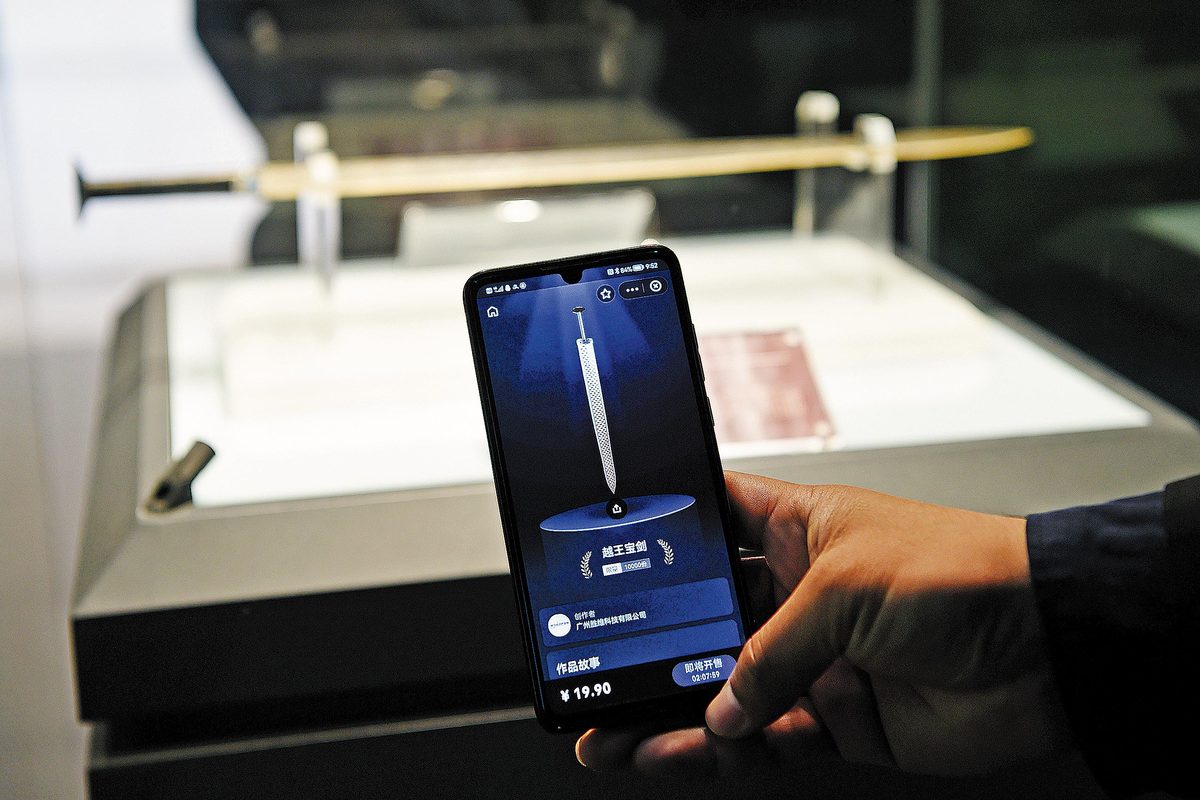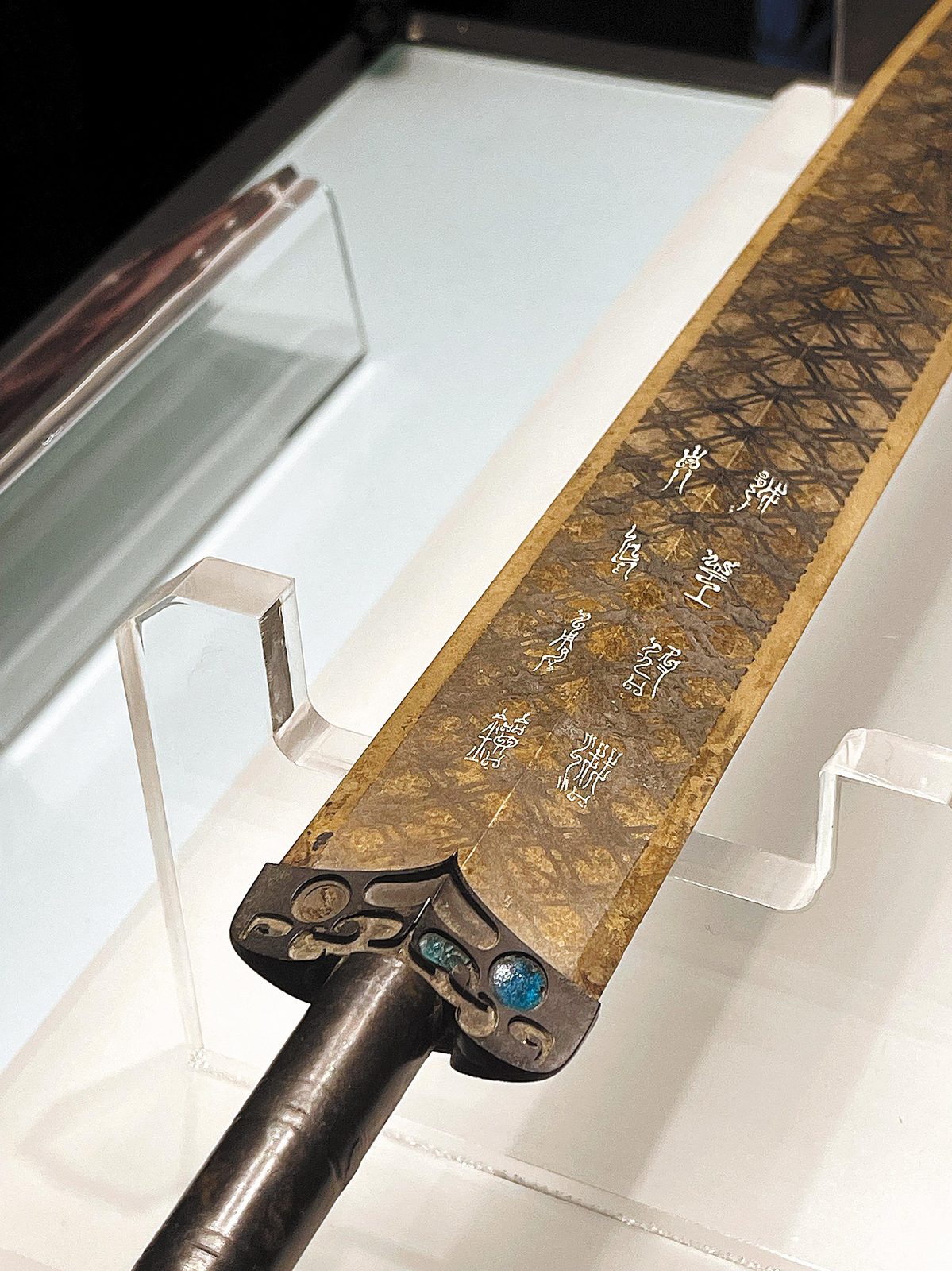Digital copies of famous sword sell out in seconds
By CHEN MEILING in Beijing and LIU KUN in Wuhan | China Daily | Updated: 2022-01-04 09:24

Netizens beginning to appreciate virtual value of online versions of historical artifacts
Historical artifacts are usually priceless, fragile and not to be touched. But these days, curious visitors can see them, play with them and make them part of their personal collections, all for just 19.90 yuan ($3.10).
In late October, digital versions of the Sword of Gou Jian, one of China's most important historical artifacts, which has retained its sharpness and whose patterns remain clear after more than 2,000 years, sold out in seconds.
Ever since it was unearthed in Hubei province in 1965, the sword has been one of the prize displays at the Hubei Provincial Museum in Wuhan, the provincial capital. Covered in delicately engraved inscriptions, mysterious black rhombus patterns and blue and turquoise inlay, it is an example of the advanced design and production techniques used to make weapons during the Spring and Autumn Period (770-476 BC) and originally belonged to a famous king of the Yue State.
The digital version, codeveloped by the museum and tech giant Alibaba, retains every detail of the original. Viewers can zoom in on a perfectly restored version after paying the 19.90 yuan fee through the Alipay platform.
"More than 600,000 people rushed to purchase 10,000 digital copies of the sword, which sold out in three seconds!" said Wang Xianfu, deputy director of the museum, adding that he didn't expect the offering would be so popular. "I didn't even get one for myself."

The idea of a digital replica is a concept based on the use of NFTs, or non-fungible tokens, which give each electronic artwork a certificate of authentication using blockchain technology. As each NFT is unique and cannot be duplicated, buyers can prove ownership. To date, the technology has been applied to a number of different items, including artworks, audio tracks, videos and games.
Wang said that because most people don't have the chance to admire artifacts from up close, a digital copy transcends the limitations of time and space, allowing history enthusiasts to avoid crowds and inspect the objects whenever they want.
"Besides, it's easier to view an artifact on your telephone than it is through a glass cabinet," he said. "It's becoming a trend for museums to develop digital replicas, which are an important contribution to creative and cultural products, and also help promote traditional culture in a way young people appreciate."
Wuhan resident Han Shijun was more than prepared to buy her own digital copy of the famous sword.
"In the past, I only ever saw artifacts in cabinets, and most of time, not very clearly. Technology can also restore artifacts, which makes me feel closer to history," she said.
Wang Yitao was not so lucky. "It sold out before I realized," he said.
But the sale piqued his interest, and he went on to buy four digital reproductions afterward. "It's interesting, and the pieces aren't expensive," he said. Indeed, many are sold for between 9.90 to 25.90 yuan.
Li Jialu, another Wuhan resident, said although the object was virtual, "owning the Sword of Gou Jian sounded cool".
In recent years, many Chinese museums have produced digital reproductions. In September, the Shaanxi History Museum released three based on the front, back and 3D images of its most important artifact, the Tiger Tally, which was used during the Warring States Period (475-221 BC) to mobilize armies.
In November, the Chengdu Museum uploaded digital versions of its famous stone rhinoceros on Alipay, and the same month, 10,000 digital versions of the Small Wild Goose Pagoda and the Bell Tower, two important heritage buildings in Xi'an, Shaanxi province, were also sold.
Zhu Jianxiong, who runs the digital collection division at AntChain-part of the Ant Group, an Alibaba affiliate-said that since October, around 10 museums, including the provincial museums of Hunan, Hubei, Henan, Hebei and Anhui, have produced digital replicas, and more than 1 million netizens have made purchases. The platform has uploaded 237 different items.
This new art form aims to introduce the ingenuity and skill of the ancient crafters who made these precious relics to a younger audience, as well as encourage greater appreciation of Chinese culture in everyday life, Zhu said, adding that the company expects to boost digital appreciation of cultural relics for both their cultural and technological value.
To prevent speculation, the platform forbids trading between netizens but allows buyers to give purchased items away after 180 days. China has pledged to promote the protection and display of cultural artifacts through technology during the 14th Five-Year Plan (2021-25) Period, Wu Yuanbin, director-general of science and technology for social development with the Ministry of Science and Technology, said in early November.
Xia Zengming, a professor at the Huazhong University of Science and Technology in Wuhan, said that digital replicas help build connections between buyers and the figures and stories related to artifacts, making it easier to spread awareness of history.
Additionally, collectors don't need to go anywhere to add to their collections or worry about buying a counterfeit. "It gives them pleasure and promotes development in the culture and tourism sectors at the same time," Xia said.
























